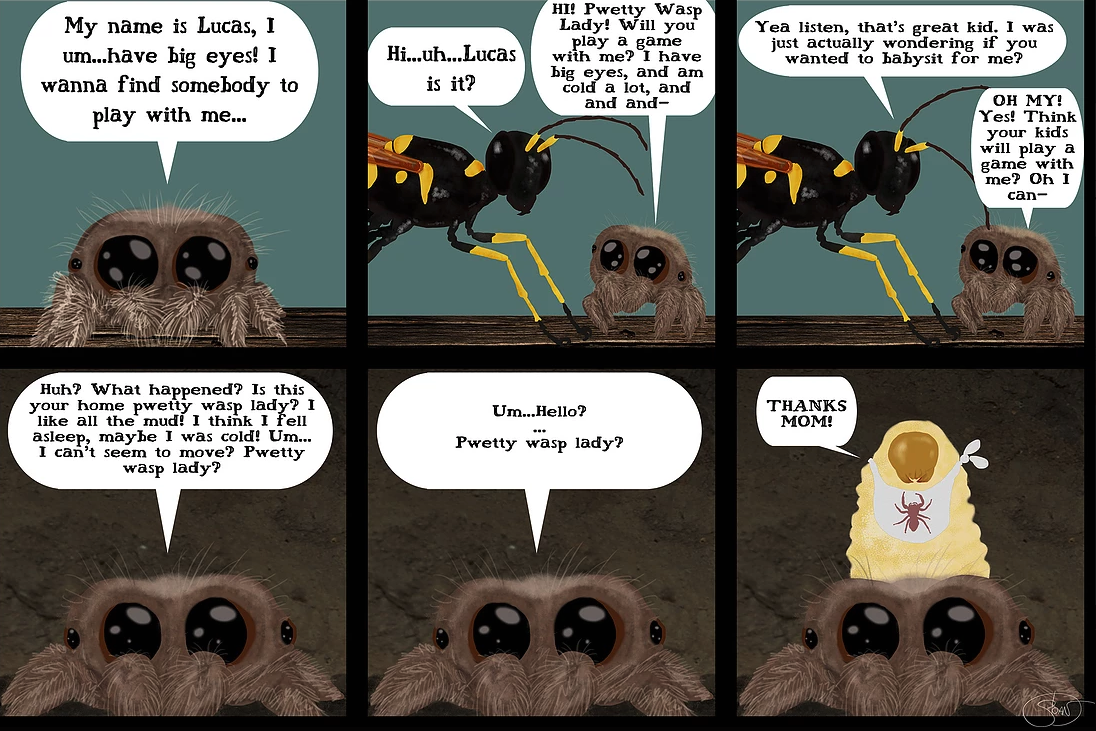Table of Contents
Group 1
<html><font size=6 face=“Arial”>Buried alive: a terror tale</font></html>
Wiki site of the practical exercise of the IX Southern-Summer School on Mathematical Biology.
Here you will find the exercise assignment and the group's products.
If you are a group member login to edit this page, create new pages from it, and upload files.
Introduction
Under a bridge in north central Florida lives a population of mud dauber wasps. These wasps are voracious predators with an extremely interesting hunting mode: female wasps are specialized in capturing and paralyzing spider preys only to store them in mud nests as a way to keep them safe (and zombie-like alive) to be devoured later by the wasp larvae. However not all mother wasps have the same preferences for which type of spider they like to offer their offspring, a pattern known as individual specialisation. In the same population there are specialist wasps, that hunt only species from a single genus; and generalist wasps, that hunt spiders from as much as 7 genera.
Specialist individuals might be more efficient in capturing and handling prey; nevertheless, if competition for that resource is high and/or the density of that resource is reduced, such specialists could reach a dead end and starve. Generalist individuals might have a lower foraging efficiency (as they must be skilled enough to hunt and capture multiple prey items), but under high levels of competition (or unpredictable availability of resources) it could be beneficial to be a jack-of-all-trades instead and a master of none.
Check the cool work from Sloan Tomlinson
Assignment
Propose a model to explore hunting strategies in mud dauber wasps and the effect of competition on coexistence of strategies.
Suggested questions
- Explore how the degree of intraspecific competition influences the prevalence (and coexistence) of specialist and generalist hunting modes.
- How does resource availability influences coexistence of strategies, or exclusion of one by the other?
- Does competition between spider species influences diversity of predator strategies?
- Would both strategies (specialist and generalist) be equally good for the offspring? Explore scenarios where larvae fed by mothers choosing different strategies obtain different levels of advantage.
Further well-grounded questions from the group are welcome.
Challenge
Interestingly, the authors found a generalist female with exceptional hunting abilities. The most generalist female was able to hunt spiders from as much as 7 different genus, encompassing spider species with a highly diverse hunting modes, and webs. Was she the female-spider version of John Wick or perhaps, as suggested, was she stealing prey from other females (a hunting strategy known as kleptoparasitism)? In such case, explore kleptoparasitism as an additional foraging strategy. In which situation (in terms of degree of competition, prey availability, and proportion of population using each alternative strategies) would that kleptoparasitism most likely prevail?
References
Powell, Erin C.; Taylor, Lisa A. Specialists and generalists coexist within a population of spider-hunting mud dauber wasps. Behavioral Ecology, Volume 28, Issue 3, 01 May-June 2017 https://academic.oup.com/beheco/article/28/3/890/3098066
Araújo, Márcio, S.; Gonzaga, Marcelo O. Individual specialization in the hunting wasp Trypoxylon (Trypargilum) albonigrum (Hymenoptera, Crabronidae). Behavioral Ecology and Sociobiology 2007, Volume 61, Issue 12 https://link.springer.com/article/10.1007/s00265-007-0425-z
Moura, Rafael R.; Pitilin, Rafael R.; Buschini, Maria L.T. Specialisation in prey capture drives coexistence among sympatric spider‐hunting wasps 2019 Ecological Entomology https://onlinelibrary.wiley.com/doi/full/10.1111/een.12743
Also, check out this cool Twitter thread https://twitter.com/LizyLowe/status/1208906297262800896/photo/1

